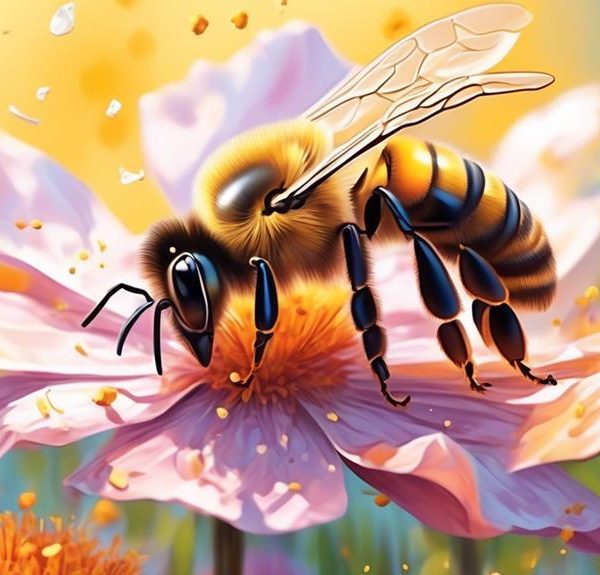Grasp the ingenious survival tactics of bees as they dodge predators, from alarm pheromones to their war strategies against hornets.
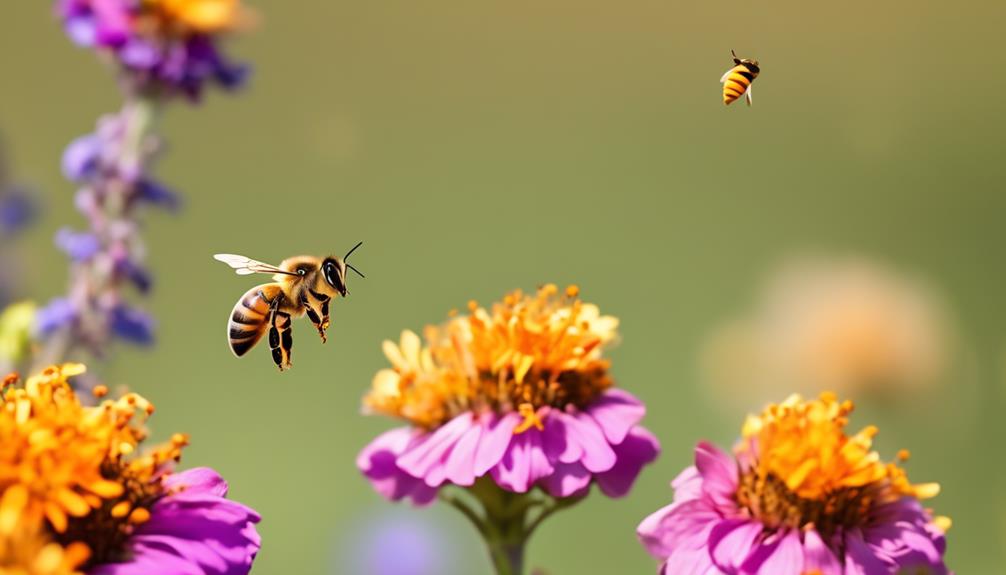
How Does a Bee Avoid Predators?
You've likely heard the theory that bees, despite their small size and seeming vulnerability, are quite adept at evading predators. But how much truth does this theory hold? It's certainly a fascinating question, isn't it?
As you begin to explore this topic, you'll discover the ingenious strategies bees employ for survival, from their use of alarm pheromones to the art of swarming. Be prepared to challenge your assumptions and expand your understanding as we delve into the surprising world of bees and their predator evasion tactics.
But, before we dive in, let's ponder a teaser: ever wondered about the battlefield strategies bees deploy against hornets, their arch nemesis?
Key Takeaways
- Bees have physical defense mechanisms such as barbed stingers and distinctive coloration to deter predators.
- Bees use alarm pheromones to communicate impending danger and trigger defensive behavior in the colony.
- Swarming is a proactive defense tactic for bees, creating confusion and making it challenging for predators to single out individual bees.
- Bees have developed tactics like "hot defensive bee-balling" to counter hornets and withstand their attacks.
Understanding Bee Predators
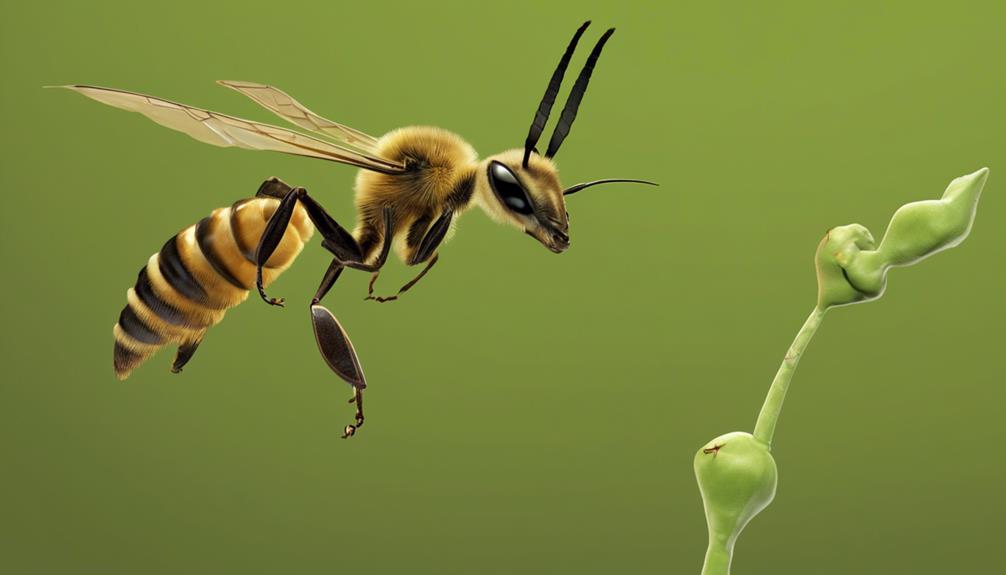
To fully grasp the threats bees face, you'll need to understand the various predators they encounter in their daily life, from birds and spiders to other insects and even humans.
Birds, particularly species like bee-eaters, starlings, and sparrows, have a taste for bees. They've evolved to snatch bees mid-flight, shaking them vigorously to remove the stinger before swallowing them.
Spiders pose another risk. Crab spiders, known for their ambush tactics, blend into flowers to capture unsuspecting bees.
Then, there are other insects, wasps and hornets, that raid beehives to feed on bee larvae.
But arguably, the most significant threat comes from human activities. Pesticides, habitat loss, and climate change induced by humans have been catastrophic for bee populations.
Pesticides can poison bees, while habitat loss reduces their foraging areas, increasing competition for resources.
Changes in climate patterns disrupt the synchrony between bees and flowering plants, affecting their food supply.
Understanding these threats is the first step towards protecting bees. Remember, they play a pivotal role in pollination, contributing to biodiversity and food production. Therefore, their survival directly impacts our lives.
Bee's Physical Defense Mechanisms
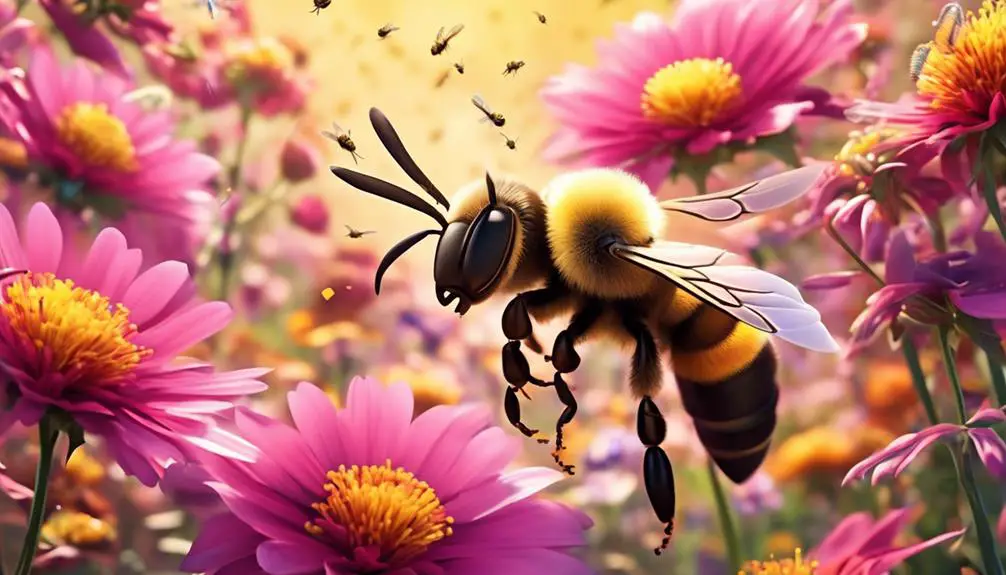
Armed with an array of physical defense mechanisms, bees aren't as defenseless against predators as you might think. Their primary weapon is the stinger, a sharp, barbed appendage packed full of venom. When a bee stings, it releases a potent cocktail of toxins that cause intense pain in most predators, effectively deterring further attacks.
But it's not just about the sting. Bees also deploy a more passive defense mechanism: their distinctive coloration. This serves as a warning signal to potential attackers, a phenomenon known as aposematism. The bright yellow and black stripes you associate with bees are universally recognized signs of danger, keeping many predators at bay.
Furthermore, bees aren't solitary creatures. They live in large colonies, and there's safety in numbers. If a predator disturbs the hive, it's met with a swarm of angry bees, all ready and willing to sting. This collective defensive strategy, known as mobbing, is highly effective.
Alarm Pheromones and Their Role

But have you ever wondered how bees alert each other of impending danger? They don't have a language like us, but they've got something else – alarm pheromones.
Pheromones are chemical signals, a sort of silent language that bees use to communicate. One particular pheromone, the alarm pheromone, plays a crucial role in predator avoidance. When a bee spots a threat, it releases this pheromone, which quickly spreads through the air, warning its colony mates about the danger.
Alarm pheromones are primarily composed of two chemicals: isopentyl acetate and 2-heptanone. Isopentyl acetate, known for its strong banana-like scent, signals the presence of a threat, causing bees to be alert. 2-heptanone, on the other hand, has an anesthetic effect on small predators, potentially deterring them.
It's fascinating how these little creatures use such sophisticated chemical signaling for survival. The spread of alarm pheromones can trigger defensive behavior in a bee colony, preparing them for an imminent attack and potentially saving their hive.
The Art of Bee Swarming
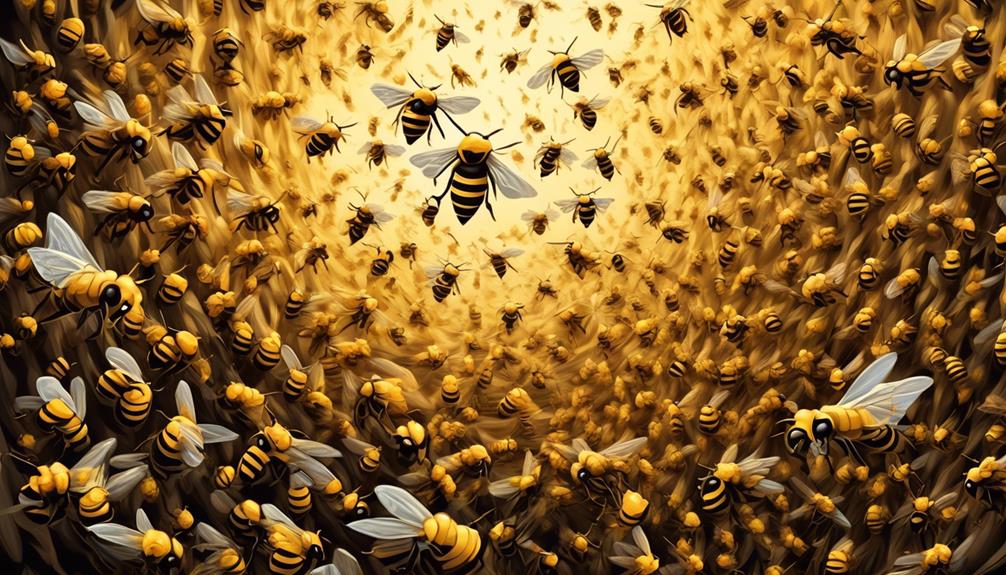
In the fascinating world of bees, swarming represents a crucial survival strategy, an orchestrated dance of thousands of bees moving in unison to establish a new colony. This spectacle, which you may perceive as chaotic, is actually a well-coordinated process. It's not just about evasion; it's a proactive defense tactic.
When resources in a hive become scarce, or the population outgrows its confines, the queen bee, along with roughly half the worker bees, takes flight. This mass exodus creates confusion, a visual smokescreen that makes it challenging for predators to single out and attack individual bees.
But swarming isn't just a random dispersal. It's a calculated risk, with scout bees taking the lead, searching for suitable new homes. They return, perform a 'waggle dance' to communicate the location's coordinates to the swarm, and guide the mass to the new site.
Case Study: Bees Vs Hornets

Delving into the dynamics between bees and hornets sheds light on an extraordinary evolutionary arms race, where survival hinges on the effectiveness of each species' defense mechanisms. Bees, as you may know, are often prey to hornets. The hornets' size, speed, and deadly sting give them a significant advantage.
But, bees aren't defenseless. They've developed a fascinating strategy to counter hornets, a tactic known as 'hot defensive bee-balling.'
When a hornet invades, bees cluster around it, vibrating their bodies and raising the temperature. They're essentially cooking the hornet alive, exploiting the hornet's lower heat tolerance. Bees can withstand up to 50°C, while hornets succumb at around 45°C. It's a risky move, but it's often successful.
However, the hornets aren't passive victims. They've been observed to send decoys to trigger the bees' defense, wasting their energy before the actual attack. It's a continual cycle of adaptation and counter-adaptation, a testament to the brutal yet fascinating intricacies of nature.
Frequently Asked Questions
What Is the Lifespan of a Common Bee and How Does It Change When Facing Predators?
Typically, a common worker bee's lifespan is around five to six weeks. However, this can change when predators are involved. Predators can shorten a bee's lifespan significantly.
In response, you'll see bees adopting various defensive strategies. They'll sting, release pheromones to alert the hive, and even perform 'buzzing' displays to scare off threats.
How Do Bees Communicate the Presence of a Predator to the Rest of the Hive?
You've asked how bees communicate about predators to their hive. They use a series of complex movements, called the 'waggle dance'.
When a threat is detected, the bee performs this dance to alert others. It's a form of coded language, expressing the direction and distance of the danger.
This way, they're not just avoiding predators themselves, but actively protecting their hive, showcasing a remarkable level of social cooperation.
Are There Any Specific Behaviors Bees Exhibit When a Predator Is Near?
Yes, bees exhibit specific behaviors when a predator is near. They'll often engage in a defensive behavior known as 'buzzing,' where they fly around the predator.
They'll also release pheromones to alert other bees.
If the threat persists, they'll resort to stinging, which is a bee's last line of defense as it results in their death.
What Factors Influence a Bee's Ability to Evade Predators?
You're looking at factors influencing a bee's evasion from predators. A bee's speed and agility play key roles. They're quick, enabling them to outfly most predators. Their ability to quickly change direction in flight also aids evasion.
Additionally, bees have sharp vision, sensing predators from afar.
Finally, they use their stingers as a last resort defense.
How Do Environmental Changes or Human Activities Impact Bee's Defense Mechanisms Against Predators?
You must note that environmental changes or human activities can significantly impact a bee's defense mechanisms. For instance, pesticides can weaken their ability to sense predators. Habitat loss also leaves them exposed and vulnerable.
Climate change can disrupt their natural rhythms, making it harder for them to evade threats. So, it's crucial that you understand how our actions can inadvertently harm these creatures and their survival tactics.
Conclusion
In conclusion, you've seen how bees ingeniously outwit predators. They're not just buzzing around aimlessly. They've got physical defenses, release alarm pheromones, and swarm to protect the hive.
The clash between bees and hornets is a prime example. Bees aren't just survivors, they're fighters using biological weaponry and strategic teamwork.
It's a sophisticated natural system, proving once again that there's more to these little insects than meets the eye.


